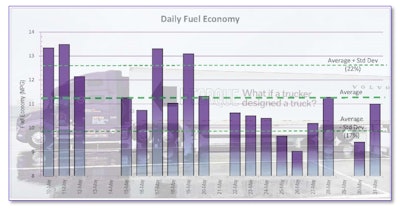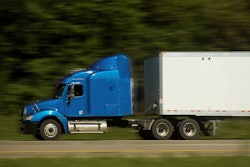When folks speak about fuel economy, quoting IFTA, pen-to-paper, dash readouts and daily vs. 30-day, do we really understand what the data is reporting? These are all different, and rarely will they either be the same or even accurate. Let’s first review what each of these values mean by looking at how they’re calculated and how to ensure accuracy.
IFTA method

IFTA stands for the International Fuel Tax Agreement. It’s an agreement among the participating jurisdictions (48 states plus the southern Canadian provinces). Because IFTA is concerned with collecting highway use taxes via event-based fuel purchases against time-based miles travelled in each state’s jurisdiction, relying on an IFTA report to document fuel economy is the worst method conceived. This is merely a tax collection method, not a fuel economy measurement method.
The problem with using the IFTA method for calculating fuel economy is that at the beginning or end of a period (monthly or quarterly), there is no standard amount of diesel fuel left in the tank. One could top off the tank on the last day of a preceding month and end the period with very little fuel, thereby inflating one’s fuel economy to appear better than it really is by realizing the benefit of a full tank of fuel’s mileage without the corresponding fuel purchase, resulting in a lower tax owed for the period. Hmm, I wonder if anyone has done that?
Thing is, it just catches up in subsequent IFTA filing periods, but if it’s bragging that you’re after this is one way to achieve temporary relevance – especially when you have large fuel tanks with which to play the game.
Pen-to-paper method
Another common method of calculating fuel economy is the so-called “pen-to-paper” method that is promoted by Kevin Rutherford via his FuelGauges application at www.LetsTruck.com.
This method is slightly different than IFTA. FuelGauges monitors fuel economy between fill-ups; the mileage between tanks is from one full tank to the next full tank (importantly, ignoring partial fill-ups!), regardless of the time period. As such, fuel economy is event-based instead of time-based.
As an example, in our case during the second quarter, FuelGauges reports that the Purple Haze, listed as “ADT100 Event,” covered 19,829 miles, purchased 1,927 gallons of diesel, while attaining 10.29 mpg. This is done by calculating the odometer reading at the last fuel purchase in the quarter in June, minus the last odometer reading from the preceding quarter’s fuel purchase in March, divided by the amount of fuel purchased during the same period. This time-based mileage and event-based fuel purchases have different bases. Event-based mileages do not show the actual miles driven in the IFTA tax-reporting period. In fact, if you use the FuelGauges’ IFTA reports, you may subject yourself to false miles reported that will not bode well in the event of an audit.
Alpha Drivers’ telematics method
At Alpha Drivers, we wanted a better, more accurate system. We developed and began using another truly accurate telematics-based method that is purely time-based on both miles and fuel consumed. We get a daily mileage report from the telematics’ internal GPS that compares to the odometer readings and stand-alone GPS, and daily fuel consumption for driving and idling from the ECM, allowing us to calculate a daily fuel economy accurately and precisely. We also receive our fuel purchase data from our NASTC fuel purchase card that is integrated directly into telematics system, eliminating fuel purchase data entry errors.
The other, often-overlooked, attribute is to compare lifetime fuel consumption to lifetime fuel purchases. By using these figures, calculating the delta between periods (i.e., days, weeks, month, etc.) we can cross-corroborate the ECM’s fuel consumption with the fuel purchases to reliably ensure irrefutable data validation. This is the only way to ensure data is uncorrupted or unaltered.
Accuracy is vital
In any method of measurement, accuracy is key. Without accuracy, “garbage in equals garbage out.” As a result, we’ve developed a multi-sourced, cross-verification method to ensure data accuracy and integrity. Without verifying the odometer’s accuracy, it does not matter which method one uses as blind reliance of IFTA, pen-to-paper or FuelGauges will all rely on flawed data input (you might even overpay your IFTA taxes). Reliance upon a pen-to-paper method using a 30-, 60- or 90-day averaging period might provide a false sense of security if that which is being measured is, itself, inaccurate. Even if the method is right, the result may not be.
First, we need to calibrate to ensure accuracy. We perform a loaded rolling distance measurement where we take a truck attached to a loaded trailer, mark the drive tire and ground on level ground, and drive forward at least ten revolutions. Mark the ground again where the tire line meets the ground.
We measure the distance between the two lines, divided by the number of revolutions to get distance per tire revolution. This figure should be something like 10.25 feet for a 22.5 low-pro tire. This figure gets plugged into the ECM via a dealer’s laptop. Additionally, there is a correction factor that can be adjusted as the tire wears down to ensure continued accuracy.
Second, we need to verify that the telematics ECM reads correctly. Here, as part of the pre-trip, the driver inputs into their daily log, under comments, the starting odometer, lifetime fuel consumption and lifetime engine hours. At the end of the day/shift, as part of the post-trip, the driver inputs the ending odometer, lifetime fuel consumption and lifetime engine hours. The difference between odometer readings and fuel consumed is a cross-verification of the intra-day miles and fuel consumed.
Third, the telematics unit has a GPS of its own. Here, it independently provides miles traveled within each state (vital for IFTA reporting). The daily aggregate total should be spot-on with the odometer readings and the intra-day fuel consumption. Our standalone GPS similarly provides state-by-state miles that can validate the telematics’ data. Checked and cross-checked.
Putting it All Together
The IFTA method was never accurate but serves as an approximation that over the long-term will approach the same number as other methods, but it takes a long time to get there. It is a tax reporting method – hardly a method that can provide useful fuel economy information that is useful to a driver or as a documentary tool to measure short-term improvements.
FuelGauges is a good tool for what it is and its intended use but it does not distinguish between the inter-day fluctuations. It, too, is a long-term tool. Several folks tout that “a 30-, 60- or 90-day average” is the proper way to represent one’s fuel economy. That is true over the long term, as this allows an owner to identify a trend that might suggest a maintenance issue.
Daily fuel economy measurements are interesting and help sustain a driver’s motivation over the long-term, but daily fuel economy measurements can vary widely based on a host of variables, such as cargo weight, weather conditions, traffic, multiple stops, elevation gains/drops, speed, etc.
As an example, during the May 10-31 period using the daily telematic’s data, we saw an average 11.21 mpg with a standard deviation of 1.37 mpg. This means that the standard deviation band in which 66% of the data resides was +/- 1.37 mpg (12.2% of the average). Thus, as shown in the chart below, one should not treat a single day’s fuel economy as representative or indicative, or even mildly suggestive of one’s performance. A single data point may be worth celebrating as it does suggest that the driver and the many variables encountered were working in one’s favor. As math illustrates, it would be foolish to suggest that the one data point is readily expected, routine or even representative.

All the data mining in the world is not worthy if it’s inaccurate. The truly best method is to calibrate the truck tires’ revolutions per mile and to ensure consistency and accuracy by utilizing a telematics solution that you can cross-validate the multi-sourced data. Using our method we can analyze any daily, weekly, monthly, quarterly or annual period’s miles, fuel consumption (driving versus idling), gross versus net fuel economy, time driving versus on-duty, and much more, to measure operational costs and efficiencies.
This is an owner-operators or small fleet’s competitive advantage through efficiency of operation over large fleets’ operational economy of scale. Seize the efficiency or lose it to your competitors, both large and small. In a tight margin business environment with low rates and higher fuel costs, one’s operational efficiency is the key to business survival, let alone thriving.
We recognize that not everyone can delve deep into the data to measure daily performance. Indeed, we do this as an adjunct to our testing and consulting business so we can provide our partners’ engineering staffs with the accurate data that they need in real, over-the-road, freight transportation in both regional and long-haul duty cycles.
When Alpha Drivers Transportation reports fuel economy performance results, we have the accurate, multi-sourced, cross-validated data documentation to satisfy the most ardent skeptics, the plentiful IFTA auditors, the EPA SmartWay program analysts, and our wonderful technology partners for whom we consult. Without these partners, we would be unable to provide all the information that we publish – for free – to educate our fellow independent owner-operators and small fleets so that they can become more operational- and cost-competitive.
Gain a competitive edge: please look and see if any of these providers can help your business: AirDog, Dana, Hot Shots Secret, Michigan MD Alignment, BASF, IdleFree, Link Mfg and Volvo Trucks North America.












